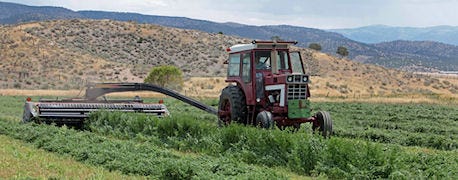
Thanks to the exceptionally warm spring Iowa and the rest of the Midwest have enjoyed this year, the 2012 hay crop is running ahead of schedule in terms of growth and maturity. In fact, the first cutting of new crop hay showed up at the weekly hay auction held at Dyersville in northeast Iowa last week. That auction took place on Wednesday, May 16. The Dyersville Livestock Sale Barn hosts one of the largest hay auctions in the Midwest every Wednesday.

New Crop Hay Already Coming To Market
"There's not a lot of hay mowed yet this spring around here, but we did have the first new crop hay for 2012 show up at our weekly hay auction last week," says Dale Leslein, manager of the hay auction at Dyersville in northeast Iowa. "And the quality of that hay was the best we have ever seen for first cutting alfalfa hay here at our auction market."
It was locally grown hay—in Dubuque County. "It was superb hay," says Leslein. "Color was good, moisture content was good. The hay was running 12% to13% moisture. The weather here lately has been just absolutely ideal conditions for baling hay. And the quality of that first-cutting hay delivered to our auction last week was the best we've ever seen for first-cutting hay since we started this hay auction a number of years ago."
What volume of hay is coming to market now? How are hay prices doing?
This time of the year, when farmers are busy in their fields, the volume of hay coming to the auction markets in Iowa is down compared to winter. Also, grass is green now so cows are grazing instead of eating bales of hay. "Volume is down now," he says. "Last week about 300 tons of hay was offered for sale here at our Dyersville auction market, that's all we had. Typically in spring and summer, the volume of hay being offered for sale at the auction markets does go down. Prices have now come down quite a bit from what hay was selling for during the winter."
Last week new crop round bales ran from $120 to $140 per ton at Dyersville. New crop big square bales sold from $125 to $160 per ton.
What is Leslein hearing from his colleagues around the country regarding the hay crop for 2012? Does it look like more hay will be produced this year? Hay was in short supply last year and was high priced. "This year, Wisconsin has been hurt as far as their first cutting of alfalfa is concerned," says Leslein. "Alfalfa fields were frosted pretty hard in Wisconsin, struck by late frosts this spring. Here in certain areas of eastern Iowa we also saw quite a bit of frosted hay."
Older stands suffered from freeze this spring; those fields are now in corn
Hay came out of dormancy earlier than usual this spring, in fact much earlier than normal, thanks to the unusually warm winter and the very warm weather in March. "Then, we had a hard freeze--up here in northeast Iowa and into Wisconsin," Leslein notes. "A lot of the older stands of alfalfa have now been removed and those fields have been planted to corn."
People don't always realize that when hay comes out of dormancy in spring and then gets hit by a fairly hard frost, it isn't the same as a frost that occurs in the fall of the year when a cornfield gets frozen. You immediately know that the corn is hurt. But with alfalfa, it takes a while to determine what the extent of damage is to the crop.
"With hay, sometimes the older stands can't take the frost as well as younger stands can," says Leslein. "If anyone has a question about their hay stand, as to whether they should save it or not, they should go out into the field and dig up some alfalfa plants in several areas. Slice the main taproot open lengthwise with a knife. If you start to see any type of yellowing of tissue inside that root, it means the alfalfa plant is dying. If that is the case, then you should probably harvest the first cutting of alfalfa and rotate that field into another crop such as corn."
How is Texas doing this spring? Do they have a good hay crop?
Last year Texas and some other southwestern states had a tremendous drought. Hay was shipped from Iowa to Texas for cattle producers to feed when they were running out of forage. "Things in Texas are fine this year," says Leslein. "They've recently had plentiful rainfall and moisture so forage crops and pasture are doing well down there. It's quite a turnaround from the severe drought that was hitting them last year."
The hay auction at Dyersville is held every Wednesday at 11 a.m., and Leslein expects to see a lot of hay baled up between now and Memorial Day. "Again, the first cutting of hay this year is good here in northeast Iowa, much better than usual," he says.
He adds, "Typically, looking back over the years, the first new crop hay that comes into our market is baled tough and wet. This spring it's just the opposite. The first cutting of 2012 hay that's been brought to our auction this spring is nice and dry with absolutely brilliant green color. The quality of hay we're producing here in eastern Iowa this year with the first crop is high quality. Farmers who produce hay should take advantage of the weather conditions right now to make some of the best hay they will ever make."
For latest hay price trends and weekly auction results go to www.dyersvillesales.com. Also visit www.fortatkinsonhay.com. The Fort Atkinson Hay Auction is held every Wednesday at 1 p.m. at the Fort Atkinson sale barn in northeast Iowa.
About the Author(s)
You May Also Like




